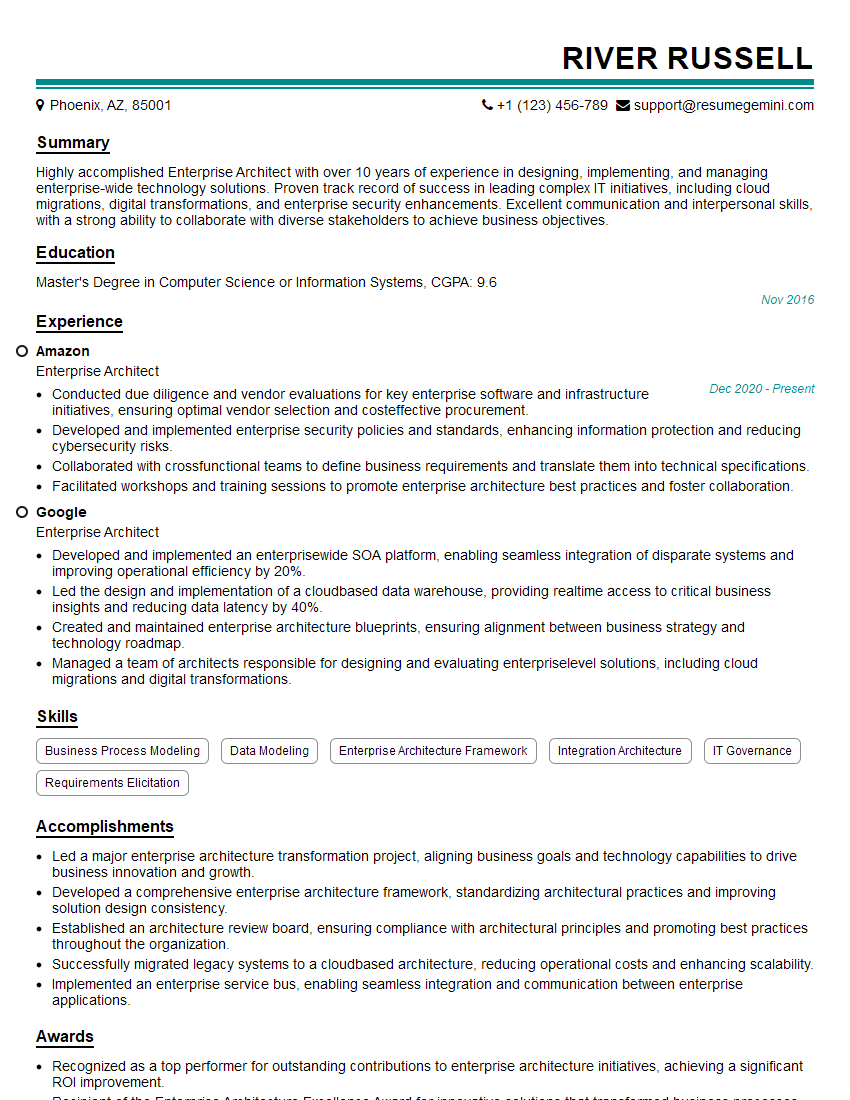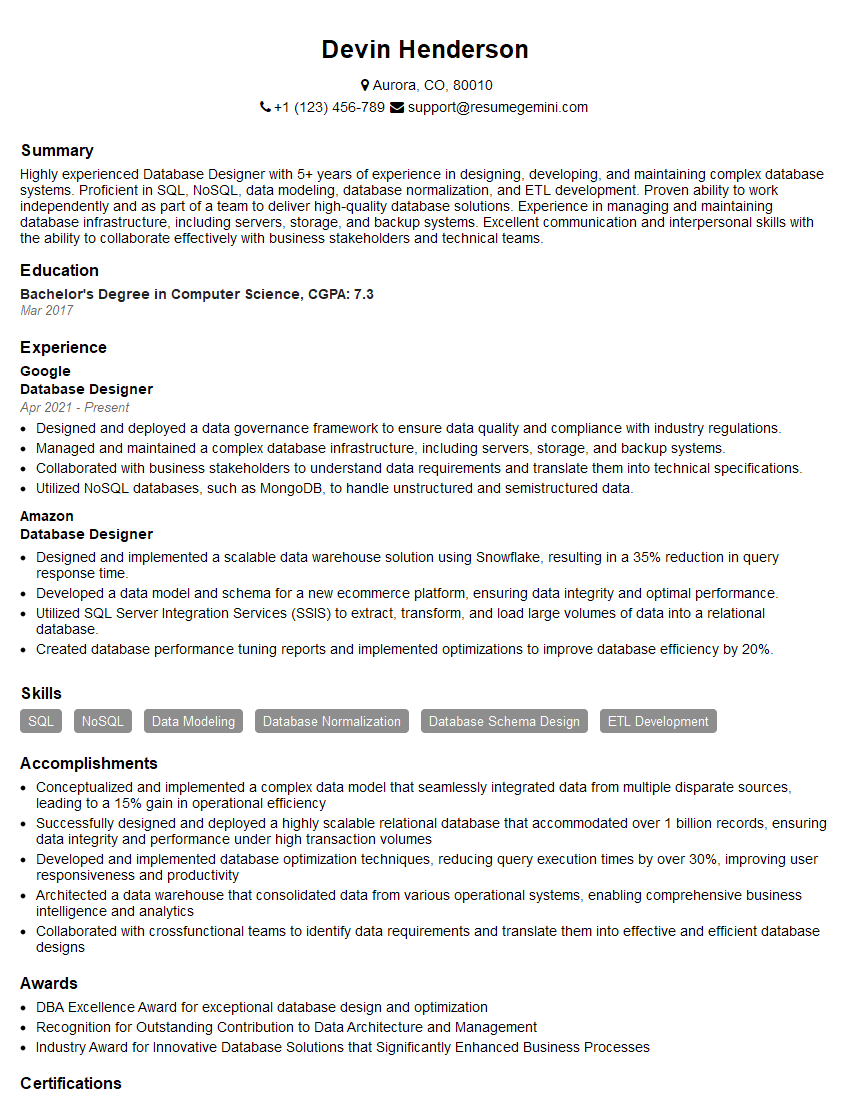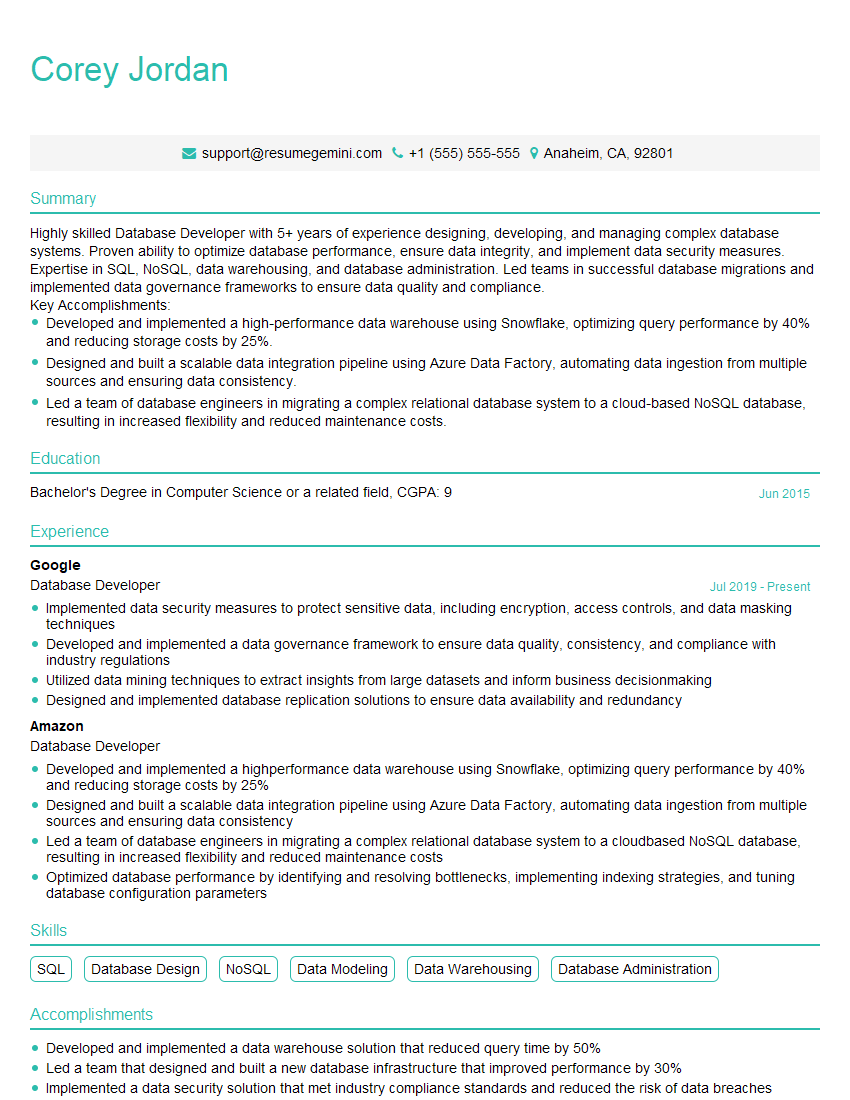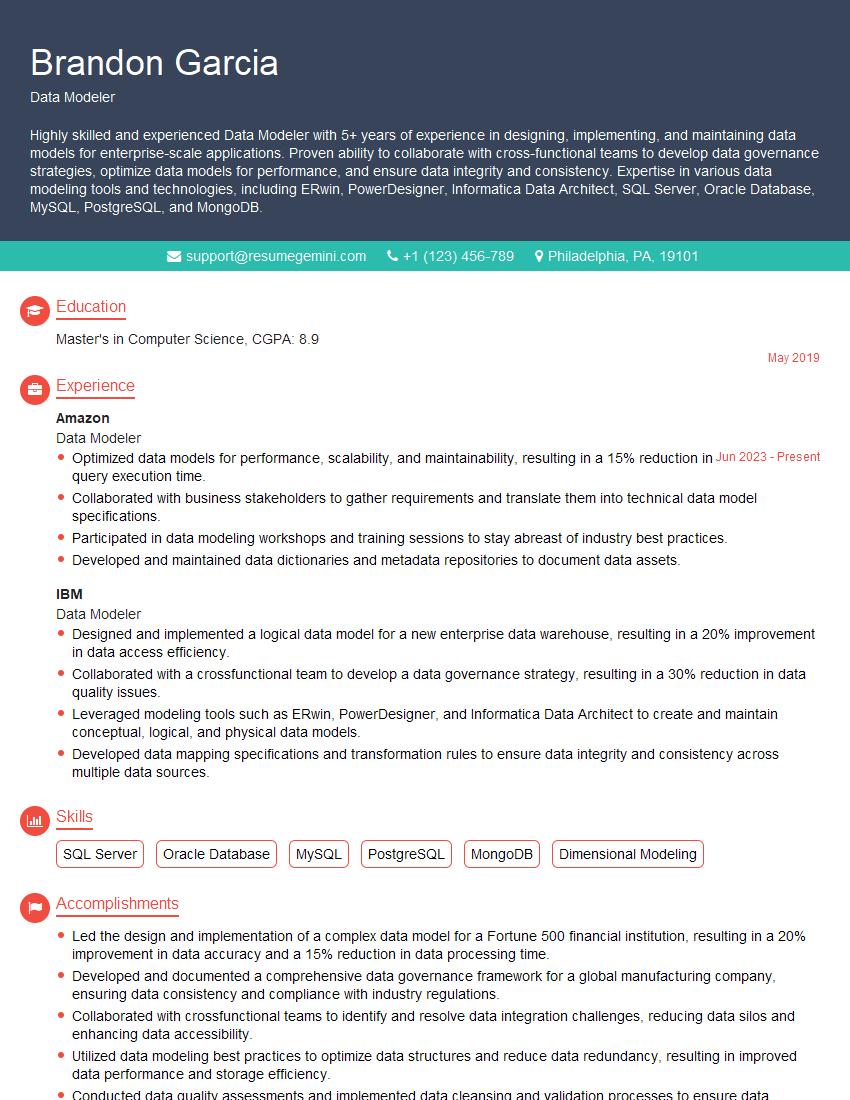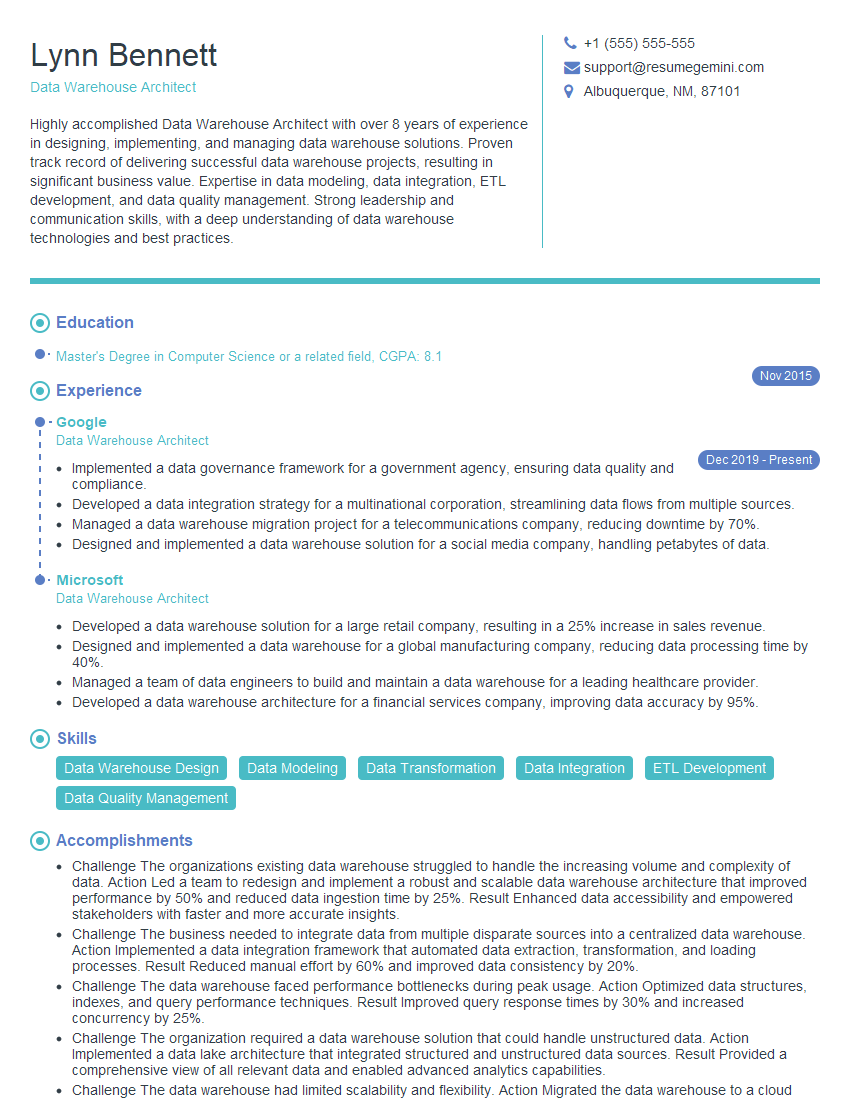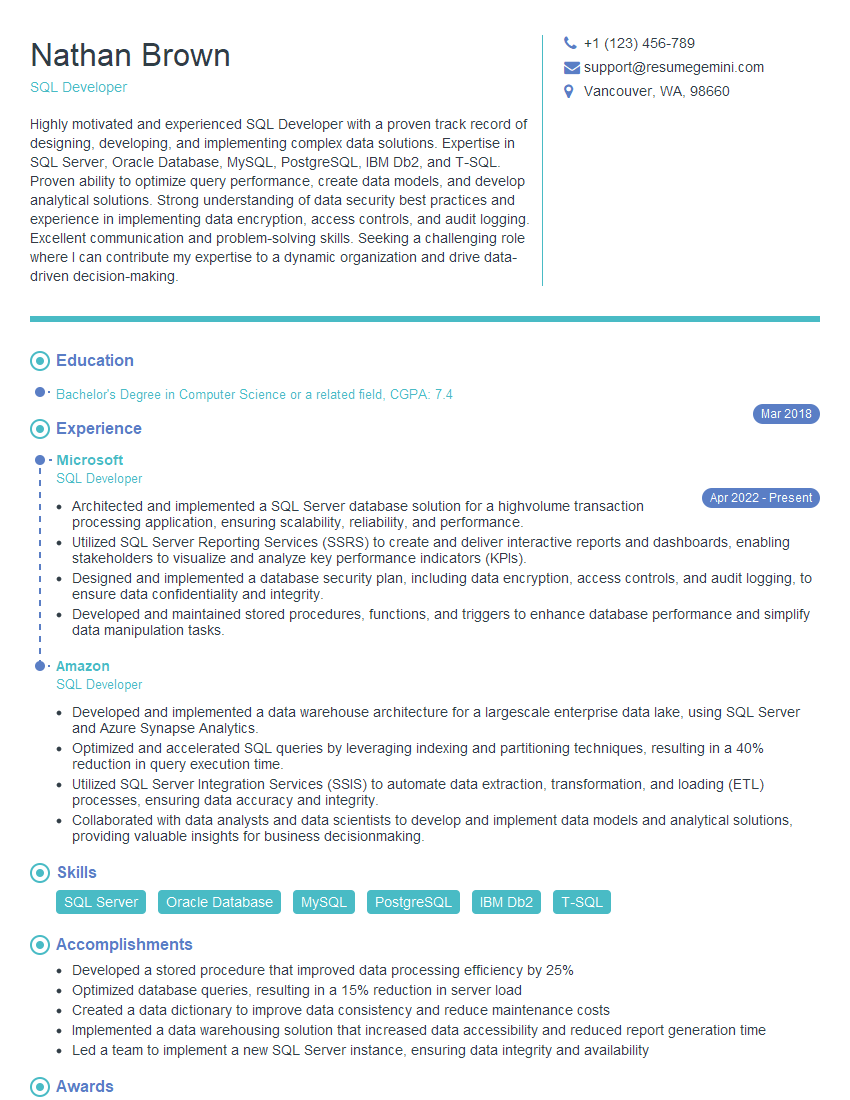Every successful interview starts with knowing what to expect. In this blog, we’ll take you through the top Entity-Relationship Diagramming interview questions, breaking them down with expert tips to help you deliver impactful answers. Step into your next interview fully prepared and ready to succeed.
Questions Asked in Entity-Relationship Diagramming Interview
Q 1. Explain the difference between an entity and an attribute.
In an Entity-Relationship Diagram (ERD), entities and attributes are fundamental building blocks representing different aspects of data. An entity represents a real-world object or concept about which we want to store information. Think of it as a ‘thing’ – a person, a product, a car, etc. Each entity is usually represented by a rectangle in the ERD. An attribute, on the other hand, is a specific characteristic or property of an entity. It describes the entity. For example, if ‘Customer’ is an entity, attributes might include ‘CustomerID’, ‘Name’, ‘Address’, and ‘Phone Number’. These are represented as ovals connected to the entity rectangle.
Example: Consider a library database. ‘Book’ is an entity. Its attributes could be ‘ISBN’, ‘Title’, ‘Author’, and ‘PublicationYear’.
Q 2. What are the different types of relationships in an ER diagram?
ER diagrams showcase different types of relationships between entities. The most common are:
- One-to-one (1:1): One entity instance is associated with at most one instance of another entity. Example: A person can have only one passport, and a passport belongs to only one person.
- One-to-many (1:M) or Many-to-one (M:1): One entity instance can be associated with many instances of another entity, while the reverse is true only for one. Example: One author can write many books, but a book has only one author. (Note: M:1 and 1:M are essentially the same relationship viewed from opposite ends.)
- Many-to-many (M:N): Many instances of one entity can be associated with many instances of another entity. Example: Students can enroll in many courses, and a course can have many students.
Relationships are depicted using diamonds that connect the related entities. The cardinality (explained in the next answer) is indicated on the lines connecting the diamond to the entities.
Q 3. Describe the concept of cardinality in ER diagrams.
Cardinality specifies the number of instances of one entity that can be associated with instances of another entity in a relationship. It defines the minimum and maximum number of occurrences allowed for a relationship. It’s crucial for designing databases efficiently and accurately.
Cardinality is usually represented using notations like:
- (0,1): Zero or one instance.
- (1,1): Exactly one instance.
- (0,N): Zero or many instances.
- (1,N): One or many instances.
Let’s revisit the ‘Author’ and ‘Book’ example. The cardinality of the relationship ‘Author writes Book’ would be (1,N) on the Author side (one author can write many books) and (1,1) on the Book side (each book has one author, in a simplified model).
Q 4. What is a weak entity and how is it represented?
A weak entity is an entity that cannot be uniquely identified by its own attributes alone. It depends on another entity, called the identifying or owner entity, for its existence and unique identification. A weak entity is represented by a double-rectangle in the ERD and is connected to its owner entity via a double line (representing a identifying relationship). The identifying relationship is typically a one-to-many relationship.
Example: Consider ‘Dependent’ as a weak entity in an employee database. A dependent (child, spouse) cannot be uniquely identified without knowing the employee they are associated with. The ‘Employee’ entity is the identifying entity.
Q 5. Explain the difference between a supertype and a subtype.
Supertypes and subtypes are used to model entities that share common attributes but also have unique attributes. A supertype is a generalized entity that represents the common characteristics. Subtypes are specialized entities that inherit attributes from the supertype and possess additional specific attributes. Think of it like a parent-child relationship. This is particularly useful for handling inheritance in an ER model.
Example: ‘Employee’ could be a supertype, with subtypes ‘SalariedEmployee’ and ‘HourlyEmployee’. ‘Employee’ might have attributes like ‘EmployeeID’ and ‘Name’. ‘SalariedEmployee’ could have ‘Salary’, and ‘HourlyEmployee’ could have ‘HourlyRate’.
Q 6. How do you represent inheritance in an ER diagram?
Inheritance in ER diagrams is represented using supertypes and subtypes, as described above. A supertype is connected to its subtypes using a relationship that indicates the inheritance. This typically involves a circle, sometimes called a ‘generalization’ symbol, connected to each subtype. Each subtype inherits attributes from the supertype and can possess its own unique attributes.
The relationship between the supertype and subtypes usually implies total specialization (every instance of the supertype must belong to at least one subtype) or partial specialization (an instance of the supertype may or may not belong to a subtype). This can also be explicitly indicated in the diagram.
Q 7. What is a composite attribute?
A composite attribute is an attribute that is composed of multiple sub-attributes. It’s a way to represent complex data structures in a more organized fashion. Unlike simple attributes, a composite attribute can be further broken down.
Example: The ‘Address’ attribute might be a composite attribute, composed of ‘Street’, ‘City’, ‘State’, and ‘Zip Code’. These sub-attributes would be represented as nested ovals within the main ‘Address’ oval in the ERD.
Q 8. What is a derived attribute?
A derived attribute is an attribute whose value can be calculated or derived from other attributes within the same entity. It doesn’t need to be stored explicitly in the database because it can be computed whenever needed. Think of it like a shortcut; instead of storing the same information multiple times, we compute it on demand.
For example, in an entity representing ‘Employees’, ‘Age’ could be a derived attribute. Instead of storing the age directly, we could store the ‘DateOfBirth’ and calculate the age based on the current date. This saves space and ensures consistency; the age is always accurate based on the stored birthdate. Another example could be ‘Total Sales’ for a ‘Salesperson’ entity, derived from the sum of individual sales transactions.
Q 9. Explain the concept of normalization and its different levels.
Normalization is a database design technique that aims to organize data efficiently to reduce redundancy and improve data integrity. It achieves this by dividing larger tables into smaller tables and defining relationships between them. This process goes through different levels (also called normal forms), each addressing specific types of redundancy.
- 1NF (First Normal Form): Eliminates repeating groups of data within a table. Each column should contain atomic values (indivisible values). Imagine a table with customers and multiple phone numbers in a single column – that’s not 1NF. We would separate this into a separate phone number table.
- 2NF (Second Normal Form): Builds upon 1NF and addresses partial dependencies. It requires that every non-key attribute is fully functionally dependent on the entire primary key. This means if the primary key consists of multiple attributes, no attribute should depend only on a part of the primary key.
- 3NF (Third Normal Form): Builds on 2NF and eliminates transitive dependencies. It ensures that every non-key attribute is non-transitively dependent on the primary key. A transitive dependency occurs when a non-key attribute depends on another non-key attribute, rather than directly on the primary key.
- Higher Normal Forms (BCNF, 4NF, 5NF): These are less commonly used in practice and tackle more complex forms of redundancy. They deal with situations involving multi-valued dependencies and join dependencies.
For instance, imagine a database for a library. Without normalization, we might have one table with book information, member information, and borrow information all together. Normalization would separate this into tables for Books, Members, and Loans.
Q 10. What are functional dependencies?
Functional dependencies describe relationships between attributes in a database. A functional dependency X → Y means that if two rows have the same value for attribute X, they must have the same value for attribute Y. In simpler terms, X determines Y.
Let’s say we have a table of employees with attributes EmployeeID, Name, and Department. We might have a functional dependency EmployeeID → Name because each employee has a unique name associated with their ID. Similarly, we might have EmployeeID → Department as each employee belongs to one department. However, Name → EmployeeID wouldn’t hold true since multiple employees might have the same name. Understanding functional dependencies is crucial for database normalization; they help identify redundancies and guide the design towards efficient database structures.
Q 11. How do you handle many-to-many relationships in an ER diagram?
Many-to-many relationships occur when an instance of one entity can be associated with multiple instances of another entity, and vice-versa. To represent them in an ER diagram, we introduce a new entity called a junction table or associative entity. This junction table acts as an intermediary, linking the two original entities. The primary key of the junction table usually consists of the primary keys of both original entities.
Imagine a database for a college. Students can take multiple courses, and each course can have multiple students. This is a many-to-many relationship. We would have three entities: ‘Students’, ‘Courses’, and a junction table ‘Enrollments’. ‘Enrollments’ would have ‘StudentID’ and ‘CourseID’ as its primary key, representing each student’s enrollment in a specific course.
The diagram visually represents this with lines connecting the three entities. Each line would have a notation indicating the cardinality (one-to-many, many-to-many etc.)
Q 12. What is a relational database?
A relational database is a type of database that organizes data into tables (relations) with rows (tuples) and columns (attributes). These tables are related to each other through common attributes (keys). The core concept is that data is structured in a way that minimises redundancy and allows for efficient data retrieval. It adheres to the relational model, which is based on mathematical set theory. Most modern database systems like MySQL, PostgreSQL, Oracle, and SQL Server are relational databases. The relationships between the tables are defined via foreign keys, enforcing data integrity and ensuring consistency across the database.
Q 13. What is the difference between a primary key and a foreign key?
Both primary and foreign keys are crucial for establishing relationships in a relational database. However, they serve different purposes.
- Primary Key: A primary key uniquely identifies each record within a table. It cannot contain NULL values and must be unique. Think of it as the main identification tag for each row. A table can only have one primary key.
- Foreign Key: A foreign key is an attribute in one table that references the primary key of another table. It establishes a link between the two tables. This enables you to look up related information quickly. For example, in our ‘Enrollments’ table above, ‘StudentID’ would be a foreign key referencing the ‘Students’ table.
In short, the primary key identifies a record within its own table, while the foreign key links a record in one table to a record in another table, creating the relationships that give relational databases their power.
Q 14. Explain the process of creating an ER diagram from a given scenario.
Creating an ER diagram from a given scenario involves systematically analyzing the data and identifying entities, attributes, and relationships. Here’s a step-by-step process:
- Identify Entities: Start by identifying the main objects or concepts in the scenario. These become your entities (e.g., Customers, Products, Orders).
- Identify Attributes: For each entity, list the relevant properties or characteristics (attributes). (e.g., Customer: Name, Address, Phone, CustomerID; Product: ProductName, Price, ProductID).
- Identify Relationships: Determine how the entities relate to each other. Consider the type of relationship (one-to-one, one-to-many, many-to-many). (e.g., A customer can place many orders, an order has one customer – this is a one-to-many relationship).
- Determine Cardinality: Specify the cardinality of each relationship – how many instances of one entity can be associated with how many instances of another. (e.g., one customer can place multiple orders, but one order is only related to one customer.)
- Define Primary Keys and Foreign Keys: Assign primary keys to each entity to uniquely identify each instance. Foreign keys will be used to enforce the relationships between tables.
- Draw the ER Diagram: Use standard ER diagram notation (rectangles for entities, ovals for attributes, diamonds for relationships, etc.) to visually represent the entities, attributes, and relationships you’ve identified.
By following this structured approach, you can create a clear and accurate ER diagram that effectively represents the data structure and relationships within a given scenario.
Q 15. How do you choose the right primary key for an entity?
Choosing the right primary key is crucial for database integrity and efficiency. A primary key uniquely identifies each record within a table. The ideal primary key should be:
- Unique: No two records can have the same primary key value.
- Non-null: It cannot be empty or contain null values.
- Immutable: It shouldn’t change over time. Changing it would require extensive updates throughout the database.
- Simple: Ideally, a single attribute should serve as the primary key. Composite keys (multiple attributes) are acceptable, but they can add complexity.
For example, in a ‘Customers’ table, a CustomerID would be a good primary key. If you’re dealing with people, you might use a unique identifier such as a National ID number. However, avoid using attributes that might change (like email addresses) or that might not always be available (like phone numbers). If a suitable single attribute isn’t available, a composite key might be necessary—for instance, combining ‘FirstName’ and ‘LastName’ in a table where multiple people might share the same name. But this is less efficient than a single-attribute key.
Career Expert Tips:
- Ace those interviews! Prepare effectively by reviewing the Top 50 Most Common Interview Questions on ResumeGemini.
- Navigate your job search with confidence! Explore a wide range of Career Tips on ResumeGemini. Learn about common challenges and recommendations to overcome them.
- Craft the perfect resume! Master the Art of Resume Writing with ResumeGemini’s guide. Showcase your unique qualifications and achievements effectively.
- Don’t miss out on holiday savings! Build your dream resume with ResumeGemini’s ATS optimized templates.
Q 16. How do you identify entities and attributes from a requirement document?
Extracting entities and attributes from requirements documents involves careful analysis. Think of entities as things or concepts—nouns in the document—that need to be tracked, while attributes describe the characteristics of those entities—adjectives or descriptive phrases.
Let’s say the requirement is: ‘The system should track customers who place orders. Each order includes order date, customer ID, and a list of items ordered. Each item has a description and price.’
Entities:
CustomerOrderItem
Attributes:
Customer:CustomerID,Name,Address, etc.Order:OrderID,OrderDate,CustomerIDItem:ItemID,Description,Price
The process involves identifying nouns and then determining their relevant descriptive details. Look for phrases like ‘has a’, ‘includes’, or ‘contains’ to identify attributes. Remember to consider data types while identifying attributes (e.g., integer for CustomerID, date for OrderDate, string for Description).
Q 17. Describe the different notations used in ER diagrams (e.g., Chen, Crow’s Foot).
Several notations exist for ER diagrams, each with its strengths and conventions. Here are two popular ones:
Chen Notation: Uses circles for entities, ovals for attributes, and diamonds for relationships. The relationship type (one-to-one, one-to-many, many-to-many) is indicated within the diamond. Primary keys are underlined.
Example: An entity ‘Customer’ with attributes CustomerID (PK), Name, and Address is represented by a circle with these attribute names inside. A relationship between ‘Customer’ and ‘Order’ could be shown with a diamond labeled ‘Places’ connecting the two circles representing the entities. The multiplicity (e.g., 1:N) would be shown by adding lines (representing relationship cardinalities) to the connector.
Crow’s Foot Notation: Similar to Chen notation but uses lines with different symbols (crow’s feet for many-to-one relationships, single lines for one-to-one, and two lines for many-to-many) to represent relationship cardinalities directly on the lines connecting the entities.
Both notations effectively represent entities, attributes, and relationships but convey cardinality information differently. The choice depends on personal preference and organizational standards.
Q 18. What are the advantages and disadvantages of using ER diagrams?
ER diagrams offer significant advantages in database design, but also have some drawbacks:
Advantages:
- Improved Communication: Provides a visual representation that’s easy for both technical and non-technical stakeholders to understand.
- Early Error Detection: Identifying inconsistencies and flaws in the data model early in the design phase helps prevent costly rework later.
- Structured Design: Facilitates a systematic and organized approach to database design, improving the overall quality and maintainability.
- Efficient Database Development: A well-defined ER diagram translates easily into a relational database schema.
Disadvantages:
- Complexity: Can become complex and difficult to manage for very large and intricate databases.
- Abstraction: While simplifying complex relationships, they also abstract away some low-level implementation details.
- Not suitable for all situations: Not ideal for very simple databases or NoSQL databases that don’t necessarily follow a relational model.
Q 19. How do you handle data integrity in a relational database?
Data integrity in relational databases ensures accuracy, consistency, and reliability of data. Several methods are employed:
- Constraints: These are rules enforced by the database management system (DBMS). Common constraints include:
Primary Key Constraints: Enforce uniqueness and non-null values.Unique Constraints: Ensure uniqueness within a column or set of columns, which is different from a primary key since null values are allowed.Foreign Key Constraints: Maintain referential integrity by linking related tables (discussed in the next question).Check Constraints: Validate that data conforms to specific rules.Not Null Constraints: Prevent null values in specified columns.- Data Validation: Input validation on application level prevents invalid data entry before it reaches the database.
- Triggers: Stored procedures that automatically execute in response to database events, like insertion or updates, enabling custom logic for data integrity checks.
- Stored Procedures: Pre-compiled SQL code used for data manipulation, which can embed data validation logic.
For instance, a ‘Check Constraint’ can ensure an ‘Age’ column only allows values between 0 and 120. Proper use of these mechanisms is key to maintaining a healthy database.
Q 20. Explain the concept of referential integrity.
Referential integrity ensures that relationships between tables are correctly maintained. It prevents actions that would destroy links between related data. Specifically, it dictates that if a foreign key references a primary key in another table, the foreign key must either contain a value that matches a value in that other table’s primary key column, or it must be NULL.
Consider a ‘Customers’ table (CustomerID as PK) and an ‘Orders’ table (OrderID as PK and CustomerID as FK). Referential integrity ensures that:
- An
OrderIDcannot exist in the ‘Orders’ table unless a matchingCustomerIDexists in the ‘Customers’ table. - You cannot delete a
Customerfrom the ‘Customers’ table if there are any corresponding orders in the ‘Orders’ table (unless you also delete those orders or set theirCustomerIDto NULL, depending on the database’s cascading settings).
This rule prevents orphaned records (records in one table referencing non-existent records in another) and ensures data consistency across related tables. The enforcement can be set up through database constraints.
Q 21. How do you model time-dependent data in an ER diagram?
Modeling time-dependent data requires careful consideration of how changes occur over time. A common approach is to include a timestamp attribute in each entity that stores the effective start and end date of the data. This allows tracking changes to attributes over time, rather than simply overwriting old values.
For example, in an ‘Employee’ table tracking salary changes:
- Instead of having a single ‘Salary’ column, we’d have ‘Salary’, ‘EffectiveStartDate’, and ‘EffectiveEndDate’.
- Each salary change would be a new record, with the ‘EffectiveEndDate’ of the previous record updated to reflect the start of the new salary.
This approach maintains a history of changes. Alternatively, you could create separate tables to track historical data, ensuring that the main table contains only current information and a separate history table stores all past data. This approach provides a clean separation and efficient access to current data, but increases database complexity. The optimal approach will depend on the scale and requirements of your database.
Q 22. How do you model recursive relationships?
Recursive relationships, also known as self-referencing relationships, occur when an entity has a relationship with itself. Think of an organizational chart where an employee can manage other employees, and those employees can in turn manage others. To model this, we create a single entity, say ‘Employee’, and add a relationship linking it to itself. This is often represented using a single entity with a foreign key referencing its own primary key.
For example, consider an ‘Employee’ entity with attributes like employeeID (primary key), name, and managerID (foreign key referencing employeeID). The managerID field indicates the employeeID of the employee’s manager. A CEO, for example, would have a NULL value in their managerID field, while other employees would have the employeeID of their manager.
Graphically, you would depict this as a single ‘Employee’ rectangle with a looping arrow representing the relationship between an employee and their manager.
Employee
employeeID (PK)
name
managerID (FK referencing employeeID)
Q 23. What are some common mistakes to avoid when creating an ER diagram?
Several common mistakes can hinder the effectiveness of an ER diagram. One frequent error is creating overly complex entities that try to encompass too much information. It’s better to decompose large entities into smaller, more focused ones with clearly defined relationships.
- Ignoring Data Integrity: Failing to properly define primary and foreign keys, leading to data inconsistencies and anomalies.
- Insufficient Normalization: Not normalizing the database properly can result in redundancy, update anomalies, and insertion/deletion problems. This makes the database inefficient and prone to errors.
- Lack of Clarity in Relationships: Vague relationship definitions or using incorrect cardinality (one-to-one, one-to-many, many-to-many) can lead to misunderstandings and implementation challenges.
- Overlooking Business Rules: Failing to capture all the relevant business rules in the ER diagram results in a model that doesn’t accurately represent the real-world scenario.
- Insufficient Attribute Definition: Poorly defined attributes can lead to ambiguity and difficulty in implementation. Data types, constraints, and nullability should be clearly specified.
For instance, instead of a single ‘CustomerOrder’ entity with all order details, separate ‘Customer’, ‘Order’, and ‘OrderItem’ entities would improve design.
Q 24. How do you translate an ER diagram into a relational database schema?
Translating an ER diagram into a relational database schema involves converting entities and relationships into tables and their corresponding columns. Each entity becomes a table, and its attributes become columns. Relationships are implemented using primary and foreign keys.
- Entities become Tables: Each entity in the ER diagram maps directly to a table in the relational database. The attributes of the entity become columns in the table.
- Primary Keys: Each entity needs a primary key to uniquely identify each row. This is usually an integer.
- Foreign Keys: Relationships between entities are represented by foreign keys in the relational database. A foreign key in one table references the primary key of another table, establishing the link between the two.
- Many-to-Many Relationships: These require a junction table (or bridge table) with primary keys from both involved entities as its composite primary key.
Example: If you have entities ‘Customer’ and ‘Order’ with a one-to-many relationship (one customer can have many orders), the ‘Order’ table would have a foreign key referencing the primary key of the ‘Customer’ table.
Customer Table:
customerID (PK)
customerName
Order Table:
orderID (PK)
customerID (FK referencing Customer.customerID)
orderDate
Q 25. Explain the concept of a view in a relational database.
A view in a relational database is a virtual table based on the result-set of an SQL statement. It doesn’t store data itself; instead, it provides a customized way to access data from one or more underlying base tables. Think of it as a saved query or a customized lens through which you view the data.
Views can simplify complex queries, enhance data security by restricting access to only certain columns or rows, and provide a more user-friendly interface. They are also useful for maintaining data consistency across multiple tables.
For example, a view might combine data from ‘Customers’ and ‘Orders’ tables to show only the customer name and their total order value, without revealing individual order details to unauthorized users.
Q 26. How do you optimize an ER diagram for performance?
Optimizing an ER diagram for performance involves careful consideration of data organization and relationships to minimize query execution time and resource consumption. Key strategies include:
- Proper Normalization: Reduce data redundancy by applying normalization techniques (1NF, 2NF, 3NF, etc.) to eliminate data duplication and improve data integrity. This greatly improves query speed and reduces storage space.
- Indexing: Create indexes on frequently queried columns to speed up data retrieval. Indexes are like the index of a book – they make finding specific information much faster.
- Appropriate Data Types: Choosing the most efficient data type for each attribute reduces storage and improves query performance. For instance, use smaller integer types where possible instead of larger ones.
- Relationship Optimization: Strategically design relationships to avoid unnecessary joins and improve query efficiency. For example, combining related data into a single table, if feasible, can significantly improve performance.
- Denormalization (with caution): In some cases, carefully considered denormalization (introducing controlled redundancy) can improve query performance, especially for complex read-heavy applications.
Remember that denormalization should be approached cautiously as it can compromise data integrity if not done properly.
Q 27. Discuss the role of ER diagrams in database design and development.
ER diagrams serve as the cornerstone of database design and development. They provide a visual representation of the data structure, allowing for clear communication and collaboration among database designers, developers, and stakeholders. They also aid in:
- Data Modeling: ER diagrams provide a blueprint for organizing data effectively.
- Requirement Gathering: The process of creating an ER diagram helps identify and clarify data requirements.
- Communication: The visual nature of an ER diagram facilitates communication and understanding among team members.
- Schema Design: The ER diagram directly informs the design of the relational database schema.
- Testing and Maintenance: A well-designed ER diagram simplifies testing, debugging, and maintenance of the database.
In essence, an ER diagram is a critical tool for ensuring that the database is designed correctly, efficiently, and effectively meets the needs of the application.
Q 28. Explain how you would approach designing an ER diagram for a specific application (e.g., e-commerce)
Designing an ER diagram for an e-commerce application would involve identifying key entities and their relationships. We’d start by identifying core entities such as ‘Customer’, ‘Product’, ‘Order’, ‘OrderItem’, ‘Payment’, ‘ShippingAddress’, and ‘Inventory’.
Relationships between these entities would be crucial. For example, a ‘Customer’ can have many ‘Orders’. An ‘Order’ can have many ‘OrderItems’, each referencing a ‘Product’. A ‘Payment’ is associated with an ‘Order’. The ‘Inventory’ entity would track stock levels for each ‘Product’.
We would then define the attributes for each entity. For ‘Customer’, this might include customerID (PK), name, email, address. For ‘Product’, it would include productID (PK), name, description, price, inventoryID (FK).
Many-to-many relationships would need junction tables; for example, ‘Order’ and ‘OrderItem’ would be linked through a junction table with an ‘orderID’ (FK) and ‘productID’ (FK) to track which products are in which orders. A carefully constructed ER diagram would then serve as the blueprint for building the e-commerce database.
Key Topics to Learn for Entity-Relationship Diagramming Interview
- Entities and Attributes: Understanding the core components – entities (objects) and their attributes (properties). Practice identifying key entities and their relevant attributes in various scenarios.
- Relationships: Mastering the different types of relationships (one-to-one, one-to-many, many-to-many) and their representation in ER diagrams. Be prepared to explain how relationships link entities and their cardinality.
- Keys: Understanding primary keys, foreign keys, and candidate keys. Practice identifying appropriate keys for entities and how they maintain data integrity within the database model.
- Cardinality and Modality: Clearly explaining the meaning of cardinality (how many) and modality (mandatory or optional) in relationships. This is crucial for accurately representing relationships in your diagrams.
- ER Diagram Notation: Familiarity with different notations (e.g., Chen, Crow’s Foot) and the ability to interpret and create diagrams using a chosen notation. Practice converting descriptions into diagrams and vice-versa.
- Practical Application: Be ready to discuss how ER diagrams are used in database design, software development, and data modeling. Consider examples from your experience or studies.
- Normalization: Understanding the principles of database normalization (1NF, 2NF, 3NF) and their role in reducing data redundancy and improving data integrity. Be able to explain the benefits and apply these principles to an ER diagram.
- Advanced Concepts (Optional): Depending on the seniority of the role, you may want to explore advanced topics like weak entities, inheritance, and subtypes.
Next Steps
Mastering Entity-Relationship Diagramming is crucial for success in database design, software development, and data analysis roles. A strong understanding demonstrates your ability to model complex systems and ensures data integrity, a highly valued skill in today’s market. To maximize your job prospects, create an ATS-friendly resume that clearly highlights your ER diagramming skills and relevant experience. ResumeGemini is a trusted resource that can help you build a professional resume that gets noticed. We offer examples of resumes tailored to showcasing Entity-Relationship Diagramming expertise; take advantage of these resources to present your skills effectively.
Explore more articles
Users Rating of Our Blogs
Share Your Experience
We value your feedback! Please rate our content and share your thoughts (optional).
What Readers Say About Our Blog
Hi, I’m Jay, we have a few potential clients that are interested in your services, thought you might be a good fit. I’d love to talk about the details, when do you have time to talk?
Best,
Jay
Founder | CEO




